#with varying degrees of watchability
Explore tagged Tumblr posts
Text
If you decide to watch the movies, a good rule of thumb is even-numbered movies are good, odd-numbered movies are mostly bad
hey gamers I’ve started watching star trek does anyone else see the romantic tension between captain kirk and mr. spock
#bless you OP#i hope you love the series#there are a LOT more too!#with varying degrees of watchability
91K notes
·
View notes
Text
Shawn Michaels: The Showstopper Unreleased

WWE has release a few Shawn Michaels DVDs over the years, but continuing on the theme of my last few wrestling-centered entries, WWE Home Video stuck with their “unreleased” brand of DVDs in 2018 with the three-disc release of Shawn Michaels: The Showstopper Unreleased (intro - I could not locate a trailer for this anywhere!). In that clip Shawn quips that the producers deserve an award for finding previously unreleased matches. I believe the criteria for this release is still similar to previous “Unreleased” collections where they may have aired on television (and thus likely in the WWE Network archives) or long discontinued VHS tapes, but this DVD will mark the first time the matches are available on disc. Also included is a new interview with Michaels that they broke up in several parts and sporadically inserted throughout the collection. The first disc is something special as it essentially is a “Best of Rockers” DVD. The first two matches are from Shawn’s rookie year in 1985 for Mid-South in quick enhancement matches for Hector & Chavo Guerrero and Jake “The Snake” Roberts. Matches serve their purpose, but it is nonetheless fascinating to see how Shawn had that already apparent potential in him way back in 1985. The remaining 11 matches on the first disc are all Rockers matches, with the first three tag matches being from their Midnight Rockers AWA days with two bouts against Doug Summers & Buddy Rose and one more with Brian Knobbs & Dennis “I’m not booked” Stamp. The two Summers & Rose matches are show-stealers that had exhilarating beginning/middle/end structures, and was fun to watch the 1980s crowd go nuts for.


The first disc is almost all AWA & WWF Rockers matches!! For the eight WWF Rockers matches, they consist of almost an all-star lineup of a golden age for WWF tag teams where they square off against the likes of Demolition, Brain Busters, Hart Foundation, Natural Disasters and Legion of Doom. The sad thing about The Rockers back then is that as charismatic and agile as they were back then, they mostly made other teams look good in their WWF run and that is the case here as they lose six of those eight WWF matches. Even worse is the two matches they win is a DQ win against the Rougeaus after Jimmy Hart’s megaphone is used, and a countout win against the Orient Express. That said, a lot of the other matches are pretty damn good, with high honors going to the Brain Busters bout, two Demolition matches and surprisingly working in a lot of good stuff against Legion of Doom. Worth pointing out is another good match against the Hart Foundation where it seems noticeable the teams missed their cue to go home because the match starts to feel there is no end in sight when out of nowhere during an abdominal stretch a bunch of wrestlers run in and an awkward impromptu brawl ensues and the match is declared a draw.

Disc two has 12 matches from Shawn’s first singles WWF run from 1992-1998. Some highlights from this are an unsurprising technical showcase with Mr. Perfect, oddly having a positive dynamic with Bret Hart to team up against the Blu Brothers in 1995 and predictable-yet-high quality formula matches during his first WWF Title run against 1-2-3 Kid and Steve Austin. Disc two has a disappointing triple tag elimination match with Shawn, Diesel and Undertaker against Psycho Sid, Tatanka and Kama filled with lots of stalling and headscratching booking for the eliminations. There is also a questionable match against Vader a month after their controversial-yet-excellent Summerslam match, where in this match Shawn takes 95% of the offense and quickly squashes Vader in three minutes. There is also a fascinating bout against Yokozuna from the summer of 1996 in Kuwait, when Yoko is nearing the end of his WWF run due to him putting on excess weight, and the match kind of expectedly plods along, until something must have clicked for Shawn to motivate Yoko into a pretty watchable match in the back half, and the two show respect afterwards which was awesome to see….until Yoko suddenly darts off to the back like he really has to go to the bathroom. The third disc consists of 10 matches from Shawn’s return run to WWE from 2002-2010. All the matches here are from RAW, so that means they follow the formula that still holds true for WWE TV main events today where it is either a cobbled together tag match, or a really good one-on-one match with interference or a hokey finish. There are a couple exceptions with worthwhile clean matches against Ric Flair during a Japan 2005 tour and against Christian in 2004 when he was building momentum with Tyson Tomko by his side. HBK’s matches against Rob Van Dam, Kurt Angle and Chris Jericho are the highlights on disc three, but all three contests have varying degrees of interference to effect the finishes, and in some cases it actually benefits the match as is the case with Angle with the story they were telling. I was delighted to see a post-RAW dark match included with Shawn teaming with Batista against Triple H and Edge. WWE is notorious for usually doing a fun untelevised promo or bonus match for the fans after the cameras go off the air with some quirky moments that would never fly in a televised match. That is the case here with Triple H doing lots of exaggerated selling and fun jawing with the crowd that absolutely ate it all up for a fun time.
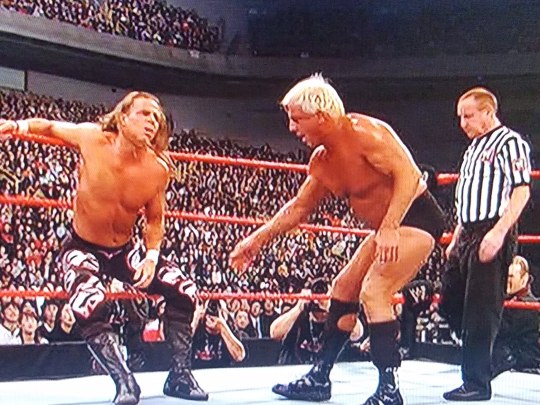
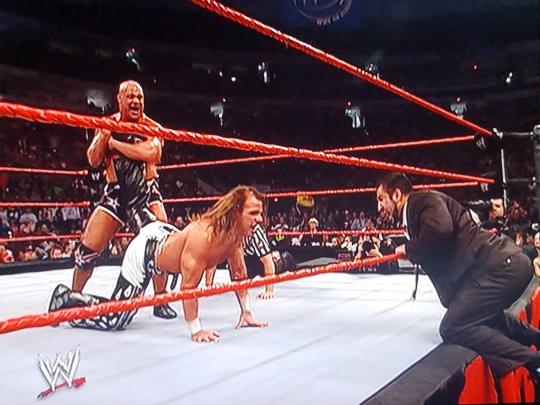
Shawn didn't disappoint in his 21st century run, with matches included here that don't disappoint against Ric Flair and Kurt Angle. A couple of promos are uncovered like Shawn doing an open Q&A with the fans when Sensational Sherri was managing Michaels early in his singles run. Another amusing bonus promo is Shawn and Diesel doing a Times Square workout session to hype up their upcoming WrestleMania 11 match with the one-and-only Todd Pentigill hosting. The several interview clips inserted throughout the DVDs has Shawn hitting on certain parts on where he was at that stage in his career and reflecting on the infamous Barber Shop break-up with Marty, his 2002 return, rebooting a less edgy, more goofball version of DX in 2006 and retiring in 2010 (this was filmed before his ill-fated Saudi Arabia return match). From these series of introspections, it was fascinating to hear Shawn think back on why he was not all-in for teaming with Jose Lathario in his WWE Title run, and hearing him settling on being a family man in retirement and turning down multiple

WrestleMania return matches. There are also a few sets of interviews with NXT talent commenting on how lucky they are to have Shawn as a teacher at the WWE Performance Center. Shawn comments a few times here too on being proud of passing on his knowledge, and it is obvious he is genuine on his passion for his new role building talent in NXT. WWE has once again amassed another recommended collection of un-vaulted matches. I am digging this format following the Piper and Macho Man sets where they break up the action every few matches with a set of interviews. Wort mentioning is about a quarter of the 35 matches here have no commentary because they were either dark matches, or from arena shows WWE use to film at regionally in the 80s and 90s and never recorded commentary for and/or lost the rights for the commentary. While there are some skippable matches, the good-to-bad ratio is largely in the positive here, and the not-so-good bouts usually at least have an entertaining backstory or era they emanate from. This all adds up for Shawn Michaels: The Showstopper Unreleased being another must-have installment of the Unreleased branding. Past Wrestling Blogs Best of WCW Clash of Champions Best of WCW Monday Nitro Volume 2 Best of WCW Monday Nitro Volume 3 Biggest Knuckleheads Bobby The Brain Heenan Daniel Bryan: Just Say Yes Yes Yes DDP: Positively Living Dusty Rhodes WWE Network Specials ECW Unreleased: Vol 1 ECW Unreleased: Vol 2 ECW Unreleased: Vol 3 Eric Bishoff: Wrestlings Most Controversial Figure Fight Owens Fight: The Kevin Owens Story For All Mankind Getting Rowdy: The Unreleased Matches of Roddy Piper Goldberg: The Ultimate Collection Hulk Hogans Unreleased Collectors Series Impact Wresting Presents: Best of Hulk Hogan Its Good to Be the King: The Jerry Lawler Story The Kliq Rules Ladies and Gentlemen My Name is Paul Heyman Legends of Mid South Wrestling Macho Man: The Randy Savage Story Memphis Heat NXT: From Secret to Sensation NXT Greatest Matches Vol 1 OMG Vol 2: Top 50 Incidents in WCW History OMG Vol 3: Top 50 Incidents in ECW History Owen: Hart of Gold Randy Savage Unreleased: The Unseen Matches of the Macho Man RoH Supercard of Honor 2010-Present ScoobyDoo Wrestlemania Mystery Scott Hall: Living on a Razors Edge Shawn Michaels: My Journey Sting: Into the Light Straight Outta Dudley-ville: Legacy of the Dudley Boyz Straight to the Top: Money in the Bank Anthology Superstar Collection: Zach Ryder Then Now Forever – The Evolution of WWEs Womens Division TLC 2017 TNA Lockdown 2005-2016 Top 50 Superstars of All Time Tough Enough: Million Dollar Season True Giants Ultimate Fan Pack: Roman Reigns Ultimate Warrior: Always Believe War Games: WCWs Most Notorious Matches Warrior Week on WWE Network Wrestlemania III: Championship Edition Wrestlemania 28-Present The Wrestler (2008) Wrestling Road Diaries Too Wrestling Road Diaries Three: Funny Equals Money Wrestlings Greatest Factions WWE Network Original Specials First Half 2015 WWE Network Original Specials Second Half 2015 WWE Network Original Specials First Half 2016 WWE Network Original Specials Second Half 2016 WWE Network Original Specials First Half 2017
#Wrestling#Shawn Michaels#the rockers#wwf#WWE#awa#marty jannetty#ric flair#kurt angle#Christian#Bret Hart#diesel#psycho sid#dennis stamp#jake roberts#mr. perfect
20 notes
·
View notes
Photo

Happy 90th Birthday the actor, Sean Connery, was born on 25 August, 1930 in the Fountainbridge area of Edinburgh.
Christened Thomas Sean Connery, named Thomas after his grandfather, his mother "Effie" was a cleaner ad his faither was a factory worked and lorry driver, so he really is a "local boy made good". Connery has said that he was called Sean, his middle name, long before becoming an actor, explaining that when he was young he had an Irish friend named Séamus and that those who knew them both had decided to call Connery by his middle name whenever both were present.He was also called "Big Tam" around Fountainbridge.
Prior to being bitten by the acting bug, Connery lived a rugged blue collar life as a labourer, a lifeguard, a cab driver and a bodybuilder. Never one to shy away from a scrap, Connery is said to have won many more fights than he lost.
Once committing to a life on the boards, Connery popped up in westerns, as a villain in a Tarzan movie and even a Walt Disney family film, 'Darby O'Gill and the Little People'. Everything changed for the Scot when he was cast (against author Ian Fleming's wishes) as the agent with a license to kill, James Bond, 007 in 'Dr. No'. Fleming initially thought that Connery was too brutish and unrefined. However, after seeing Bond come to life in 'Dr. No', Fleming came around, to the extent that he wrote a Scottish lineage in Bond's background.
Connery essayed the suited hero in five more 'official' Bond adventures, retiring the role for good with the unofficial Bond film, 'Never Say Never Again', in 1983.
Finding his creative footing after Bond took awhile. While always an actor with great range, Connery struggled against being typecast in a role that the world wasn't ready to see him walk away from. Even so, he continued working as a leading man with varying degrees of success. Despite a spotty run of films, he's always watchable and starred in some unjustly overlooked gems, such as the exciting 'The Great Train Robbery' (which features Connery running across the top of several train cabins at 60 mph with no stuntman!), Casablanca-esque 'Cuba' and my favourite of his post Bond films, the immortal 'The Man Who Would Be King', with best friend Michael Caine.
In 1987, everything changed with Connery's Oscar winning performance as Mike Malone in 'The Untouchables'. As a tough, Irish mentor to Kevin Costner's green Elliot Ness, Connery owned every scene he was in. He was funny, scary and relentless in his quest to clean up the streets of Chicago and teach younger agents how to survive in the wild, wild Midwest. I disagree with Sickboy in the Irvine Welsh book Trainspotting who slates The Untouchables and the Oscar by saying, " (That) means fuck all. It's a sympathy vote.
He went on to star in number of hit films, including 'The Rock', 'The Hunt for Red October' and of course as the father of another iconic screen hero in 'Indiana Jones and the Last Crusade'.
A wee fact I picked up when researching this post was that Sean donated his entire million dollar fee from 'Diamonds Are Forever' to the Scottish Education Trust.
Connery was married to actress Diane Cilento from 1962 to 1973. They had a son, actor Jason Connery.
He has been married Moroccan-French painter Micheline Roquebrune since 1975 and retired from filmmaking in 2003, although he didn't officially confirm his retirement until he received the American Film Institute's lifetime achievement award in 2006
As well as his Oscar Big Tam has a number of other accolades, having been polled icon
films"The Greatest Living Scot" and "Scotland's Greatest Living National Treasure". In 1989, he was proclaimed "Sexiest Man Alive" by People magazine, and in 1999, he was voted "Sexiest Man of the Century".
FountaiIf you want more info and pics of Sean Connery, go check out his website here
https://www.seanconnery.com/
80 notes
·
View notes
Text
I mean...that's all a staple of star wars. The original trilogy had a lot of backfill bc it Started at Ep 4. Just because we want to know what happened doesn't mean we wont see it, simply that it's not the story being told NOW.
I agree that the show itself suffered, but I don't think its Just because Filoni doesn't understand how to tell the audience what he wants to tell them. You're forgetting the production schedule he was under, how EVERY single previous SW show impacted if he ever got to PRODUCE Ahsoka. Or that he has to make this series watchable for ppl who have never seen and will never watch Rebels. He had an impossible task given to him and did it with the understanding this may be his only shot at completing a story he started over a decade ago WHILE carrying the responsibility of running SEVERAL OTHER SHOWS with varying degrees over overhead and budget. That's nuts.
He's also like. Trying to ensure that he leaves enough off the table that he ensures he keeps his job and can continue to tell SWs stuff in the future. Was the execution perfect? No. Oh hell no, the first two eps were so worrying, but...yeah he's gonna leave some shit unanswered so he can make a pitch for a show/movie that ANSWERS THEM
I think Ahsoka has been overcooked and undercooked in Filoni’s brain at the same time, I think he’s spent so long thinking about this story he wants to tell that he’s no longer writing the connections that the story needs, that those of us outside his brain haven’t had the last ten years of simmering with to assimilate into our background noise, while also I think he hasn’t spent enough time really digging into the smaller details. Sabine’s character is the epitome of this for me–there’s clearly so much thought he’s given her in this show, the little details in that room that are so packed full you’d need to pause the video to see everything, where you can see Ezra’s helmet or Sabine’s helmet on the quick pan through the scene, where the scene she cuts her hair is a callback to Kanan cutting his hair as he’s ready to step back onto a new path, the Ezra hologram that was specifically for her, she’s allowed to be angry and messy, etc., you can’t say that Filoni didn’t give her a ton of thought! But she’s also undercooked in this show because there’s this entire relationship she had with Ahsoka that takes place off-screen and dramatically changes their dynamic without acknowledging that it’s a change for us, the audience. And there’s an entire motivation for “Why the hell does Sabine want to be a Jedi?” and “Why did Sabine set aside her Mandalorian armor?” that’s just not there because I think Felony has spent so much time thinking about Sabine’s journey, about her connection to Ezra and how to weave Ahsoka as a mentor (because of Ahsoka’s own issues with masters and apprentices, he wants to play on those themes), that he’s been writing this in his head since he first finished the Rebels finale’s script, that he’s no longer writing it on the actual paper for us the audience. I can’t shake the feeling that he’s spent too long with this story in his head, so he’s just made connections that have become part of the scenery for him, like, of course Sabine set aside her armor, of course Sabine was training with Ezra’s lightsaber with Jedi training, of course she’s Ahsoka’s Padawan, meanwhile I just finished watching Rebels and am going, “Dave, what the hell are you talking about, none of that was in the show I just finished speedrunning to watch this show!”
3K notes
·
View notes
Note
How do you feel about movie soundtracks nowadays? I feel like the composers are limited and aren't allowed to be as creative as they once were.
Take Danny Elfman for example, his movie soundtracks were incredible and so great to listen to. You can practically visualize scenes from his movies by just listening to the soundtrack, especially Spider-Man 2.
So what happened?
I had to sit on this ask for a few hours and I think you said it all in the second sentence: “the composers are limited and aren't allowed to be as creative as they once were.”
I think it’s something we’re seeing at large in most industries, but I’m gonna stick with the movie industry or else this will become a dissertation instead of just an essay. It’s an industry, no way around it, movies need to make money. Even indie movies made with a $10,000 budget have to make their money back. Then look at a movie with a $1 million to $300 million budget. Suddenly it’s not just a small loan or car on the line, but it’s a movie studio. It’s a quarter of a billion dollars. Even smaller budgeted movies try to mitigate their risks, and studios are uber-controlling of films, more than ever, nowadays. And it’s really hard to have a mainstream hit without going to one of the handful of major studios. Of course all of us on here seem to love A24 and all, but they’ve yet to have a mainstream box office smash. (Note that I love a lot of A24 movies.)
Now, every aspect of a movie is streamlined to make it as marketable to as wide of an audience as possible. That’s why movies are and always have been a mass medium! There are a few (to a few hundred to a few thousand) people working behind the scenes to make it happen and get it to an audience. Studios want movies to have as big an audience as possible, and so everything is conceived not with the intention of being good, but for being watchable, enjoyable, bingeable, marketable, inoffensive. It’s all to rake in the dollars and show a profit for shareholders. It’s always been a business, but now with things like social media, every audience opinion can now be seen by creators and, more worryingly, the producers and studios funding the creators. We see fan service change storylines in the middle of series. This happened a bit in the old days, but now? Look at the Star Wars sequels.
I think there are still filmmakers out there doing their old thing and exactly like you illustrated with Spider-Man 2, they have a visceral effect on the audience. I was listening to the Brokeback Mountain score earlier and without looking at the track, I could also visualize the scenes. Of course, we’re still talking varying degrees of mainstream movies, but it’s still worth exploring. For the record, I’m not trying to attack Marvel movies here, I enjoy them on occasion. But it’s the easiest and most obvious example. There are outliers and a lot of old timers that are still at it, but they are less often found in mainstream movies. I’d say that Christopher Nolan, David Fincher, Denis Villeneuve, and Martin Scorsese come to mind first when I think of directors who always have iconic scores, no matter what. I’m sure there are others, but these are mainstream ones (not Marvel mainstream though) where there’s still creativity felt, but they’re special filmmakers imo.
I think studios are also rushing productions more than ever because they need a quick turnaround when movies are still getting a buzz. It takes a lot of time to be meticulous with details that audiences don’t even notice, so many (especially big money ones) don’t. That’s why Marvel movies come out one after the other, because if they took the time to make everything really, well, good and well-rounded, it’d take too long, and they wouldn’t make more money from it. So they don’t do it. The answer is money. They can get away with making things the way that they do (manufactured, formulaic, paint-by-the-numbers with a fill in the blank score) because it makes the same amount of money (or more) than a more original movie would.
#this got long#i hope this all made sense#i love talking about this tho#capitalism#movies#movie talk#*writing#asks#anonymous#also i didn't mention this but i love danny elfman
1 note
·
View note
Photo
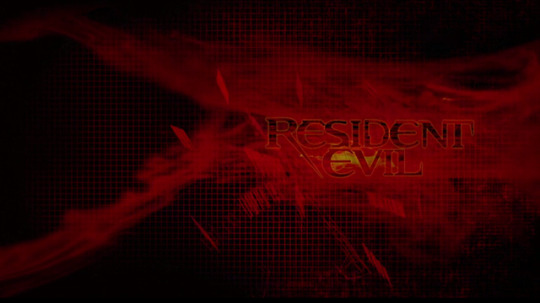
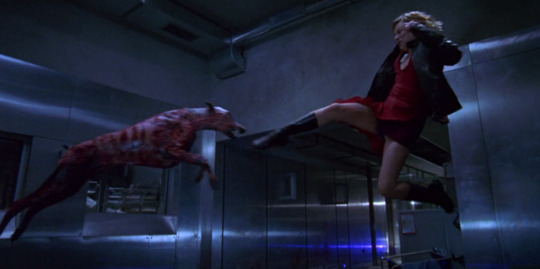
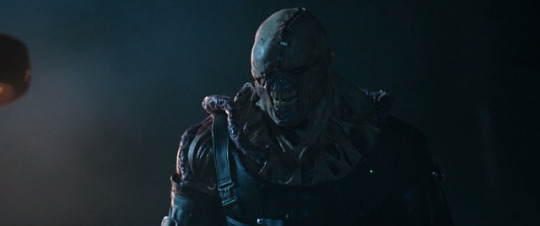
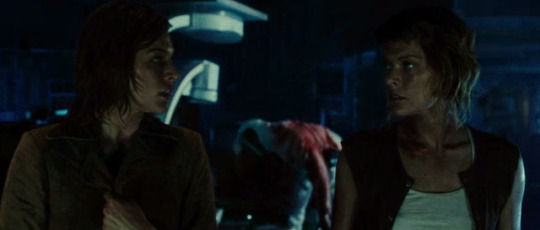
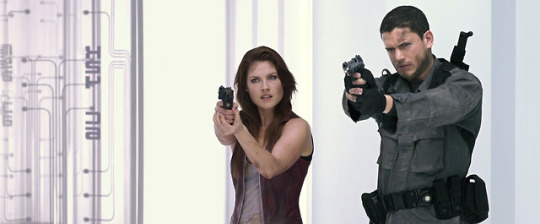
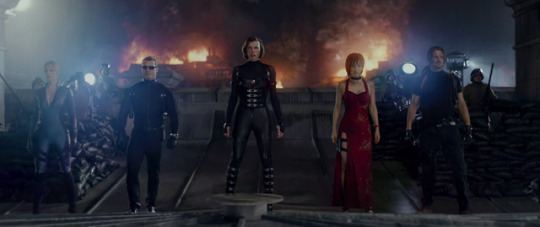
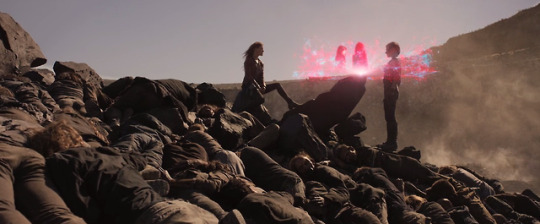
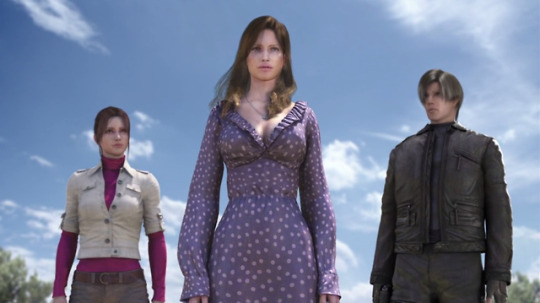
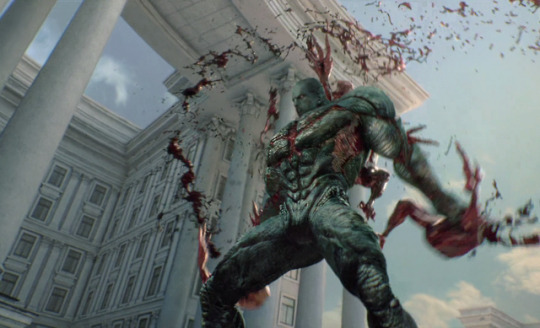
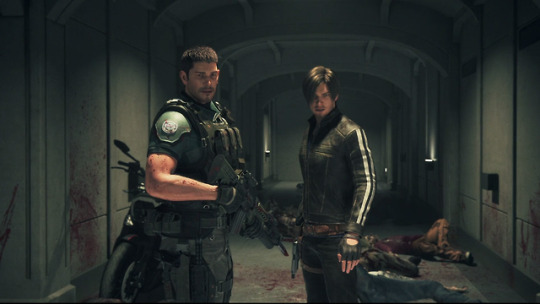
The horrific Resident Evil playthrough, interlude three
I just finished watching all of the Resident Evil movies I could get my hands on. When I told people I was doing this as the last part of my great year-long playthrough, they all let out groans and said something along the lines of, “Ugh, don’t you wanna end on a good note?” Undaunted by these words and fueled by my ability to tolerate crappy cinema, I moved forward, courageously making it through nine of these suckers...which, to be fair, ranged from surprisingly enjoyable to just as terrible as everyone warned me about.
Before I begin, it’s important to note that we’re dealing with two separate film series here. There’s director Paul W.S. Anderson’s Resident Evil Hollywood films, which are the ones that most people know about. Then there are three Japanese-made CG movies that are canon and co-exist alongside the stories of the games. The Anderson movies are...mostly ass. The Japanese ones are okay.
Let us start with the ass first.
Resident Evil - The first RE film came out in 2002, which means that what little CG it has is laughably dated and it’s refreshingly small-scale when compared to its sequels. The movie’s a fan fiction remix of some themes from Resident Evil 1, except with none of the characters from the games present. Instead, we have Paul W.S. Anderson’s wife Milla Jovovich taking center stage as Alice, the former head of Umbrella security in a secret base called the Hive that goes to hell when some dude tries to steal viruses. The entirety of the action takes place in the Hive, and we get a surprisingly tiny number of monsters, with just your garden variety zombies, a few Cerberus and a single Licker showing up. Even though she does run up a wall and kick a Cerberus in the face, Alice is at her most realistic here (she turns into a dual wielding mutant with the ability to make the camera go into slow-motion whenever she wants in all the other films), there’s a nifty laser grid scene that all the sequels keep referencing when they want you to feel nostalgic, and the Hive’s sentient AI, the Red Queen, is compelling enough that Capcom eventually stuck her in Resident Evil: The Darkside Chronicles. Aside from this movie being full of British actors who do REALLY awful American accents, sounding like they all have mouths full of sausages, Paul W.S. Anderson’s first take on Resident Evil is probably the most watchable one he made.
Resident Evil: Apocalypse - Okay, this one is watchable too, but in more of a popcorn-munching “lol, this shit is dumb” way. It steals the general plot of Resident Evils 2 and 3, with Raccoon City getting infected, but ups the cheese by a hundred. Alice is now a thirteen-year-old boy’s version of a BADAZZ woman, with lots of guns and a bare midriff, and she teams up with Jill Valentine, who resembles her game self in looks but not exactly in personality. Together, they’ve gotta escape Raccoon City along with Carlos Oliveira, who is possibly the only character from the games who is done a great service in these Anderson movies, which make him much more likable even if they couldn’t find an actual Hispanic actor to portray him and had to settle for an Israeli instead. Oh, and Nemesis shows up, because one of the dudes from the first movie who accompanied Alice into the Hive gets experimented on and turned into what honestly looks like someone’s Halloween costume. The writers commit a cardinal sin at the end of the flick by humanizing him, having him suddenly remember his TRUE SELF and help the good guys, but aside from that screw-up I admit that I had a goofy grin on my face throughout several parts of this movie. After Nemesis blows up the Raccoon City station and murmurs his one line of dialogue- “STARRRRRSSSS” - I even kinda felt like clapping. So yeah, Apocalpyse is idiotic fun.
Resident Evil: Extinction - Here’s where the movies stop being mildly entertaining and become varying degrees of either “meh” or just plain bad. Extinction’s biggest problem is that it makes the weird decision of having the entire PLANET be wiped nearly completely clean by Umbrella’s virus, giving the franchise the most generic setting imaginable for a zombie flick - a post-apocalyptic world. And even though this film features Claire Redfield and actually has Alice fight a Tyrant that looks the part, I feel that by turning the environment into Mad Max the filmmakers missed the entire point of the franchise. Resident Evil isn’t really about a “what if” scenario with mankind dying and zombies taking over the world. Instead, it’s about how humanity manages to cope in a time where zombies are used by corporations for terrorism purposes - hence the franchise’s “bio-organic weapon” catch-phrase for its creatures. It’s about how brave people live on in an era that just happens to feature biopunk monsters as a deadly fact of life. It’s about the evil that resides within a world that is pretty shitty, but hasn’t completely gone to shit. By turning the whole planet into the same ol’ zombie playground that we see in most popular fiction starring these workman-like horror tropes, Extinction - which probably thought it was upping the stakes - instead just feels sorta dull, and anyone who views the film today is probably going to see it as a weaker version of The Walking Dead. Oh, and it ends with Alice discovering clones of herself, which will only serve to screw with the loose continuity of these movies as they go on.
Resident Evil: Afterlife - This one starts with Alice’s clones raiding the Umbrella facility in Tokyo, and the whole sequence - which feels like it should be the finale - is reduced to a few minutes of special effects in the beginning. (This is foreshadowing for the next two films, which both end with hints of giant, climatic battles that mostly happen off-screen, if at all.) The first thing that I noticed when watching this was how slow-mo kicked in every five minutes and how the camera seemed to linger on bullets, and I eventually remembered that this film was released during Hollywood’s obsession with 3D during the early 2010s. This explains Afterlife’s IN-YOUR-FACE-IN-THREE-DIMENSIONS action scenes, which are initially pretty in a music video sort of way but become overdone and tiresome as the movie goes on, kinda like a Zack Snyder film. (I place Paul W.S. Anderson in the same “style over substance” category of director as both Zack Snyder and Michael Bay, by the way.) Anyway, Afterlife deals with Alice teaming up with more survivors to try to find a secret ship haven free of zombies. Along the way she runs into Chris Redfield, who looks more like a janitor than the jacked BSAA agent that he is in the games, and Chris and Claire Redfield have a quick sibling reunion and fight Wesker in a scene with choreography shamelessly stolen from Resident Evil 5. It’s pandering fan service and sort of diverting, but ultimately none of it matters. Chris disappears after this movie and is never seen again, and Afterlife is more interesting as a specimen of 2010 3D excess than it is as an actual narrative.
Resident Evil: Retribution - Retribution amps the pandering fan service that Afterlife dabbled in to new levels. Ada Wong is here, played by Li Bingbing but dubbed by her original voice actress, Sally Cahill, probably because Li’s English isn’t that great. Leon Kennedy and Barry frickin’ Burton show up, both looking pretty much like their in-game counterparts. Even Michelle Rodriguez and a few other faces from Paul W.S. Anderson’s first Resident Evil flick make an appearance, thanks to the fact that this movie has clones up the wazoo and uses them to handwave away any series inconsistencies you could think of. So you’re got fan service for the people who like the games and fan service for the folks who liked the first movie, and on top of it all the film has the extreme 3D that its predecessor possessed and a buttload of battles because it all takes place in a giant Umbrella simulation facility full of stuff that can easily be wrecked. By now the plot to these things has gotten more scrambled than my eggs in the morning, but I will say that thanks to its inclusion of classic characters, Retribution is more or less tolerable. There’s even a bit of characterization this time around, thanks to a little hearing-impaired clone girl who Alice takes under her wing and begins to care for, and the movie ends on an okay cliffhanger in a Washington DC under siege, promising epic things to come in the next movie. Unfortunately... Resident Evil: The Final Chapter - I really did not enjoy The Final Chapter for a myriad of reasons. First of all, the Washington battle promised at the end of Retribution never happens. Instead, we fast forward to several months later, when Alice is (big surprise) the only survivor, and EVERYONE she was with in the last flick - Ada, Leon, the little deaf girl - is gone and never mentioned ever again. Wesker, who Alice was working with in Retribution, is back to being a bad guy for poorly explained reasons. Another bad scientist dude that Alice killed in Extinction also returns for even worse reasons, because supposedly Alice only offed his clone three movies ago. But wait, this “real” bad scientist dude is also revealed to be a clone as the TRUE bad scientist dude shows up in the movie’s last act! AND THE ULTIMATE TWIST (look away now if you actually care about spoilers) is that Alice is HERSELF a clone of the original daughter of the Umbrella corporation’s founder who died of a degenerative disease and served as the basis for the Red Queen AI. The idiotic thing is that this daughter was said to be the progeny of Dr. Charles Ashford in Resident Evil: Apocalypse, but this movie retcons her to be the spawn of Dr. James Marcus. The Final Chapter, in fact, screws with continuity to a degree I have rarely seen before in a long-running film franchise. Yeah, the framework tying this series together got weird as soon as clones were introduced, but previously it seemed that Paul W.S. Anderson at least cared about his own messy fan fiction. Here? It’s like he forgot what he’d spent the last 15 years building up to and ended on one sloppy fart. If this weren’t bad enough, The Final Chapter is edited in that god awful “shaky cam, lots of fast cuts” way that I hate. In fact, I counted something like twenty cuts in a scene of a few seconds when Alice is attacked by a creature, which means that this film won’t just baffle you with its disregard for continuity - it’ll give you a headache too.
Resident Evil: Degeneration - After watching an array of live-action flicks that took random Resident Evil threads and mashed them together with the elegance of a splattered turd, it did feel good to switch things up and move to the CG movies that were actually put out by Capcom. This 2008 offering takes place in between Resident Evils 4 and 5, stars Claire Redfield and Leon Kennedy, and deals with a virus breakout in an airport and some of the pharmaceutical company backstabbing that occurred in the aftermath of Umbrella’s destruction. It’s all stuff that feels like it could have come from a lesser gaiden game - perhaps in the same vein as the first Revelations title - and it kinda gives off that “so-so anime movie” vibe, especially because the dubbing always sounds a tad off. Nevertheless, Degeneration’s still a breath of fresh air compared to the Anderson series, and there’s a nice gag where Claire’s searching for a weapon in the airport, someone hands her a physical umbrella, and she looks at it and is like, “Hm, didn’t see this coming.” (Lollerskates.) The main issue I have with Degeneration is how “plasticky” everyone looks - it’s hard to realize how far computer animation has advanced in the last decade until you look at Degeneration’s stiff visuals and compare them to the other CG films. Also, Leon’s characterization is terrible. He’s meant to be a super serious badass, I guess, but he mostly just looks like someone rammed a Samurai Edge up his sphincter. I prefer my Leon Kennedy to be the “Don’t worry Ashley, I’m comin’ for ya!” version from Resident Evil 4, or at least a dude with a little sass to him. The guy in Degeneration is about as interesting as a board. Resident Evil: Damnation - Damnation is a noticeable step above Degeneration, both in computer animation, which really got better from 2008 to 2012, and in all-around presentation. The dubbing’s still somewhat wonky with that same anime movie vibe, but the characterization is on point, and Leon, who’s taking center stage once more, is just like his RE6 self. Speaking of RE6, this movie channels that game’s themes of international terrorism with a plot that involves rebels in a made-up Eastern European country using Lickers and Las Plagas in an effort to fight for their freedom, only to learn that lo and behold, the nefarious female president who’s seized control of their nation has her own B.O.W.s - in the form of Tyrants - at her disposal. Leon’s caught in the middle of this mess and ends up befriending some of the rebels, and Ada Wong’s also infiltrated the country to manipulate the president. Ada and Leon’s interactions are as insubstantial as they’ve been in pretty much every game that isn’t the recent RE2make, but we do get a cool fight between Ada and the president, who for some reason knows substantial knife fu. There’s an even better battle between Tyrants and Lickers in a city hall square, and Leon gets throw against pillars, regularly takes hits that would kill a normal person and pilots a tank alongside one of the rebels who looks a lot like Chris Redfield but isn’t Chris Redfield. This dude serves as the film’s sympathetic character - a guy torn from his peaceful existence thanks to political wrangling and is tricked into using B.O.W.s to try to achieve a brighter future. It ends with the fella severely injured but learning how to live and move forward in a world infected with nefarious bioweapons, which is the very theme that the Anderson flicks ditched around movie number three. So good work for side-stepping previous failures and recognizing what Resident Evil is all about, Damnation.
Resident Evil: Vendetta - If Degeneration’s a so-so anime movie, and Damnation a good anime movie, then Vendetta is just a good movie in general, with no “anime” distinction needed. The dubbing’s finally pretty decent, for one, and the story takes place in between RE6 and RE7, teaming Leon and Chris Redfield up with - HOLY CRAP - Rebecca Chambers, who’s been AWOL since Resident Evil Zero. They’ve gotta stop an arms dealer from bio-nuking New York and doing nasty things to Rebecca, who resembles his dead wife, and along the way Leon pilots a motorcycle on the freeway with his feet while shooting at Cerebrus with his hands. Nearly all of the movie’s considerable action segments are punctuated with rapid fire John Wick-style gunplay, and it works. It’s like the folks who made this film realized that the coolest part of Resident Evil 6 was the point where Leon and Chris point their guns at each other for a few seconds before deciding that they need to put their differences aside and cooperate, and even though you could conceivably fault Vendetta for leaning heavily towards the “action” side of Resident Evil rather than the “horror” side, it’s a well-paced film that finally gives us a substantial interaction between two series mainstays beyond the one minute they shared with each other in RE6. Also, people are still posting GIFs from Vendetta’s action sequences all across Tumblr and forums whenever arguments break out over whether Chris or Leon is TEH COoLER Resident Evil protagonist, so Capcom obviously did something right. If we get another computer animated film, I imagine it’ll lean more heavily towards horror since that’s where the series has gone recently...but hopefully the path of improvement that we’ve seen from Degeneration to Damnation to Vendetta won’t be broken.
And with that, whew, I’m done with RE movies, at least until the rumored Hollywood reboot that’s supposedly drawing inspiration from Resident Evil 7 comes out. (It can’t be worse than The Final Chapter, I suppose.) I can’t say that my friends were wrong when they warned me that half of these would be shite, but I also can’t say that I ended on a bad note, because Vendetta was pretty good.
After all this, my grand playthrough and consumption of all Resident Evil media is about to finish Next post I make will be a last look at the franchise as a whole...and what a year’s worth of zombie headshots taught me. All screencaps taken by me.
20 notes
·
View notes
Text
The Ballad of Buster Scruggs
(Joel & Ethan Coen, 2018)
Returning two years on from the fairly underwhelming, and pretty quickly forgotten Hail Caesar, the Coen brothers return with a project whose format has been much talked about. Was it intended to originally be a 6 episode miniseries, or was it always going to be a movie? It doesn’t really matter either way, but having seen it I feel like some of these 6 segments might have been a chore in isolation, and work infinitely better as shorter parts of this larger whole.
Buster Scruggs, unlike their very traditional previous western, True Grit, runs the gamut of Coens styles from the sheer absurdity of stuff like Raising Arizona, and Burn After Reading, to the darker, doom laden, dread and melancholy of No Country For Old Men or Blood Simple, the traditionalist, throwback class of the aforementioned True Grit, or Hudsucker Proxy, or the existential nightmares they conjured up in things like A Serious Man and Inside Llewyn Davis, it’s all here, and unified the Coens have conjured up as fine a deconstruction of the western genre since Clint Eastwood’s Unforgiven over a quarter of a century ago.
To work through each section briefly, the titular Ballad of Buster Scruggs allows Tim Blake Nelson to cut loose in his own inimitable, and unforgettable way. It’s one of those pitch perfect marriages of actor and part that should earn damn near iconic status if enough people see it. The story he finds himself in the middle of (shout outs to Clancy Brown and David Krumholtz for playing their parts, however small) starts out outrageously amusing, and grows more and more absurd to the point of almost total idiocy. It’s blackly comic in the most black way, but so over the top it might prove off putting to many. Thankfully they have the good sense to keep it short enough that it never seriously outstays its welcome.
It’s followed by Near Algodones, another black comic work of absurdist madness, though slightly less outrageous than what comes before it (at least once Stephen Root finishes damn near stealing the whole movie), a little gentler in its tone, it’s ultimately no less bleak in its outlook, no less concerned with violence and death, it gives a nice little role to Ralph Ineson, and provides James Franco an opportunity to be as down to earth and natural as he may ever have been on screen.
These first two segments are probably the two that most define what I was talking about when I said that some of these episodes may have been a little much to stomach in isolation, so crazy are they both. Yet with the end of Near Algodones the movie entirely turns itself on its head.
In Meal Ticket, Liam Neeson, and Harry Potter’s now unrecognizable Harry Melling inject absurd amounts of melancholy into the most abstract segment in the movie. Told primarily through a sequence of very short scenes, with minimal use of much dialogue beyond the relatively incidental, the brothers and their two mournful performers craft a story less specific to the old west, more timeless and universal. It’s a mood piece of sorts, built around visuals and actions, asking the viewer to piece together the fragments they see, and infer meaning, and work their own way towards the conclusion, every bit as bleak as the finales of the stories that came before it.
After this comes the closest the movie can provide to respite. The Tom Waits led All Gold Canyon perhaps tonally could have come before Meal Ticket in the movies descent from dream into nightmare, but placed here breaks up the darkness of the movies second half a little bit. It’s another segment reliant more on action, with most of the dialogue proving on the incidental side. At the heart of it Waits is magnificent, it’s always nice to see him back on screen, and aided by the gorgeous photography of Bruno Delbonnel, now in his third collaboration with the brothers, this is maybe the most purely watchable chapter of the film.
It’s followed by another more traditional piece of work, in The Girl Who Got Rattled, with Zoe Kazan leading the way, aided by a terrific couple of performances from Bill Heck, and Grainger Hines. It’s the longest segment of the movie, along with the previous the most straightforward one, and the one with the closest thing to a proper arc, the one that feels the most like it could (again, probably in conjunction with All Gold Canyon) stand as a story in its own right. Heck and Kazan are a winning duo, and just when it starts to threaten to drag compared to what has come before, Hines steps up and elevates the final act at the centre of a sequence that needs someone special to make it work.
Finally comes the comparative chamber piece, The Mortal Remains. Shooting it in a studio where the rest was shot on locations may have been a practical choice rather than a creative one, but it adds to the movies meta qualities significantly, gone are the wide open plains, and in its place something that feels like a cross between the opening act of The Hateful Eight (the amount of talking in this segment would drive QT wild) and something out of Coppola’s Dracula. The oddballs in the carriage, the darkness and fog that surrounds them, the whole thing is unsettlingly off kilter, its another No Country For Old Men trick where the brothers sort of bring their film screeching to a halt at the last to force you to think a little bit more.about what you’re seeing. The quintet of performers, the great Tyne Daly and Brendan Gleeson, Jonjo O’Neill who finds himself gifted with the monologue of a lifetime, (speaking of Unforgiven) Saul Rubinek, and veteran Chelcie Ross, who is another of the movies show stealers, all bounce brilliantly off one another, off set each other, and keep this nightmare grounded to some degree in reality, a long way from the pure artifice in which The Ballad of Buster Scruggs began a couple of hours prior.
For all of its comic absurdity, and the storybook gimmick that strings the whole thing together, Buster Scruggs is a movie in which in spite of dabbling in generally pretty accessible, crowd pleasing or skin crawling storytelling, the Coens are able simply through structure, and their unmatched handle of tone to probe deeper into what they really want to explore. From the varying explorations of violence and preoccupation with death in all its complexities, to the use of songs, and mixture of tones, the Coen brothers latest effort is filled to the brim with all kinds of details that should reward repeated viewings. It’s a magic trick of a movie only the best can pull off, basically very light on its feet as a viewing experience, but enriched by a staggering amount of depth to be explored, and open up your understanding of what they’re going for just as they shrink their world, and box you in.
#the ballad of buster scruggs#joel and ethan coen#tim blake nelson#james franco#ralph ineson#stephen root#liam neeson#harry melling#tom waits#bruno delbonnel#zoe kazan#bill heck#grainger hines#tyne daly#brendan gleeson#saul rubinek#jonjo o'neill#chelcie ross#2018#reviews#film#films#movie#movies#joel coen#ethan coen#coen brothers#the coen brothers#coen bros#coens
3 notes
·
View notes
Text
Dateline: 1987-ish
Location: undisclosed submerged area of operations, North Atlantic. …ish
You can mess with a lot of things in a submariner’s life, and he will simply gripe about it and move along. Extend a run by two weeks. We already expected it. Commence field day? Already have a cleaning spot picked out, a plan for a nap. Want to send me up topside in a blizzard? Set fire to the galley? Fry electronics by taking a wave over the sail on the surface? Clog the sanitary systems? Poison the air requiring all hands use emergency air breathing masks plugged into a plumbed network of air lines? That’s what they pay us for. Bring it on.
But there’s some things they don’t pay enough for. High up on that list is bad or no movies.
This is how the rules read: If you don’t have a genuine emergency, mission, or better idea (read: liberty port) don’t mess with movie night. Do not break the machine. Do not break the film (or tape). Do not turn the mess decks lights on in the middle of the movie.
And above all, do not mess with the movie storage locker or contents. There’d better be a full loadout, functionally watchable, and preferably entertaining.
Now of course, there is a wicked little paradox here: the only thing worse you can do to a submariner than mess with movie night is to make the rule that you can’t mess with movie night.
See, here’s the thing: behind the swagger, lack of decorum, and general sacrilege that oozes from each submariner, and freely flows when there’s a crew of them, their general disregard and heathenish ways only seem faithless to others. The submariner’s creed, “we are the crew, we are the ship” completely excludes reverence for the silly decorum of others. That irreverence isn’t a byproduct. It is a critically functional facet of a mindset formed in an environment unimaginable to most people. “Nothing is sacred” is a sacred codex.
And so the deadly game of survival underwater inevitably requires shenanigans, just to get the irreverence flowing and all warmed up…
The run to our undisclosed location was slow. The operation was mind-numbingly boring to 90% of the crew. And so, the movies began once shakedown, drills, field day, and all the stuff we do getting settled into a deployment is under control.
I remember the exact moment this transition took place. I was basking in the downtime of taking my turn as aux operator in Sonar. We rotated in on the main sonar stack (listening post) periodically, then out to take a little while to rest the eyes and ears. The aux operator was the spare man, the guy free to move about the cabin. The one guy available to fetch coffee while he’s out of the shack. And in this capacity, I had just exited the shack headed toward the ladder down toward the mess decks. The predictable but loud thrum of the inside of the submarine was suddenly punctuated by a peculiarly angry voice.
“The Care Bears Movie?!”
Now at this point I want to acknowledge and guide the two types of people still reading this far: the first type will assume I have reported what was actually said, and that was that.
Why, bless your little ol’ hearts.
The second group will understand, to varying degrees based on experience, that more was said, that it was vulgar, and therefore either needlessly confusing to the uninitiated or fully implied and understood to those who are wise in the ways of sailors.
I’m not saying the feelings being emoted were unholy. I’m just saying I suspect the ensuing Cosmic Blush caused the 400-cycle bus to dip a few hertz in shame, heaving an acoustically-detectable electronic sigh into the Deep.
See, before every deployment, some young buck gets awarded the privilege of anonymously accompanying the Supply Officer to Squadron, where he could help choose the movies we’d take to sea. What was chosen was chosen, there was no arguing the titles once the hatch closed and we submerged into the Darkness of the Big Bathtub. By some sort of cosmic law probably related to penance for our vocabulary, it was understood to be also forbidden to just “not watch” a movie taken onboard for deployment. If one movie were to get watched, they all had to get watched ( you see how that “one crew-one screw theme keeps coming back?).
The outcry I heard was not one of disgust from a qualified Submariner, but one of qualified horror.
Sure enough, our mystery sailor had put the Care Bear Movie into the box with the others. Now, please don’t try to wrap your head around why Squadron had stocked Care Bears in their library. I’m 35 years deep into this bizarre case, and still got nuthin’. It was just there, alright?
And of course, that meant it HAD to be watched.
This couldn’t have happened even two years previous. Up till then, we used the old 16mm film projectors. In the Eighties, this meant a harsh demarcation of available movie titles. On film, we got older movies, lots of B-grade material. On the new VHS Format, suddenly Care Bears was possible.
And now, by virtue of its malevolent presence, required.
Dear friend, we had a term for something tested to extremes, that came from the mechanical type rates. We would say we “Hydro’d” a thing to indicate it had endured extreme testing conditions. In the spirit of what can only be described as rhapsodic resignation, we embraced this Care Bears. It was screened at least twice a day for two weeks.
In recounting this tale, it is at this moment that I suddenly hesitate to bring you, dear reader, further into the ebullient cesspool of Submarine humour. But I can’t leave you hanging either, now can I. I’m just saying Let it now be known that you have been warned.
Our uniform at sea is referred to as a “poopy-suit. A one-piece easy-in, easy-out garment with a single zipper from neck to the netherworld built especially to enable a sailor to quickly go from sleeping to fighting for survival, unhampered by the one thing he never had to begin with, modesty issues. It is equally conducive to the semi-conscious divestiture by an exhausted sailor who has spent the last 3 days in arduous testing, or nail-biting suspense. The last thing a bone-weary sailor needs is complicated clothing.
By the Official Manual of Uniform Regulations, beneath the poopy suit was to be worn a white tshirt and underwear. By the Eighties, the tshirt was often a printed shirt, a personal and as vulgar a message as the times allowed. Of course, no one knew whether you had a plain white tshirt or not unless you zipped down the poopy suit a bit.
As the hydro-testing of the Care Bears exuberantly continued, there came a point when things suddenly went from darkly hilarious to diabolically collaborative. And it all started with Pink Floyd.
As many qualified, off-duty submariners as could were lounging Conspiratorially on the mess decks for screening #45 of “A Care Bear Movie”, when someone up front suddenly had an epiphany. As behind him Care bears were glowing a rainbow beam at some evil-doer meany-doo-doo-head, he seductively unzipped his poopy suit in front of us down to his navel. He stretched it aside to reveal his Pink Floyd “Dark Side of the Moon” prism tshirt. It was perfect. How perfect? Well I’ll tell you. In two watches, a matter of 12 hours, we went from a boat-full of submariners obsessed with Care Bears to actually believing we WERE Care Bears.
We all had different names and powers though. In addition to “dark side of the moon” beam, there was AC/DC’s “Highway to Hell”, Rolling Stone’s giant Tongue, Cuervo Gold, Jack Daniels, Triumph motorcycle on a highway way… you get the idea. Things with a hint of being worthy of becoming a “Stare” came out from the woodwork. These became our mythical superpowers. We would unzip and expose our tummies at hilariously awkward conversational moments. Passing each other in the passageways, which required the two parties turn sideways and slide past, became fodder for coy, often lewd insinuations based on our particular hidden “Stare”. It evolved into a friendly challenge - woe be to you if you were caught in a challenge with a plain white tshirt. Well, until one guy turned it into “Blinded by the Light”. That was a stroke of genius right there.
But as childishly silly as most of it was, there were other moments. One torpedo man had a flag shirt - just a simple one mind you, nothing garish. We would kazoo-choir our way through a shortened rendition of the star-spangled banner, suddenly a little awkward and maybe a little moved at the displayed patriotism. An ET had a print of John Holland, an iconic image of the inventor and founder of modern submarines. His “stare” was generally met with a respectful grunt of acknowledgment, as if his opponent was grudgingly acknowledging having been trumped.
Mine, or at least my favorite of what I had available that run, was a “Keep on Truckin’”shirt. Whenever space allowed, I’d always strike the pose, yaknow, one foot impossibly extended forward creating the illusion of a giant step being taken. That was my Stare, and it was used to convey reaching a little further than you thought you could. I didn’t mean it to be entirely serious, but the element of genuine encouragement stood fast. By the time we stationed the inbound maneuvering watch, I had it perfected.
And so it came to be on a cool September morning as we were bumped and nudged and coddled up towards the pier by the tug, all the aft line-handlers, yours truly included, greeted and encouraged our pier-side counterparts with our new communication skills, successively beaming them our particular “Stare”. I even struck my most dramatic “Keep on Truckin’ pose yet, what with not being inside the boat and all, but yaknow, they just weren’t pickin’ up what we were layin’ down.
We finally gave up, to attend to that which stood between us and getting off the boat and off to our families or, well, wherever the boat wasn’t. We reminded ourselves a little, but not terribly too late, that when in the sunshine, we had to at least try to act like the other sun-walkers. We ahemed and coughed our way back in juvenile seriosity to a modicum of decorum just in time for the colors to shift from the bridge to the aft deck where we stood, as the final act of transitioning from underway to officially in-port.
As we all snapped to salute the colors, wouldn’t you know it, there stood our torpedo man, giving his surreptitious stare with one hand exposing his Care-Bear Stare chest flag, eyes locked straight into the eyes of the Ship’s stars and stripes. It was in that beautiful moment that I realized that the warped, defiant, oppositional and sometimes arrogant mind of a US Submariner is a National Treasure, capable of Care-Bear Staring down the Enemy and the Sea he tries to hide in, armed with nothing but a tshirt and a poopy-suit to load it into for launching.
You cannot win against this.
Happy Veterans Day, ya cocky bastards.

0 notes
Text
Movie Review | Deep Cover (Duke, 1992)

In 1990, Laurence Fishburne appeared in King of New York as a volatile enforcer working for Christopher Walken’s drug lord and ran away with the movie, threatening to turn any scene into a bloodbath with his mere presence. (To paraphrase the late, great Eazy-E, his identity by itself causes violence.) In 1991, he played a contemplative father figure in Boyz n the Hood trying to provide guidance to his son and prepare him for the grim realities of the streets. In 1992, he played an undercover cop in this movie, combining the best qualities of both performances. I cite the years because even though there were movies in between that I can’t attest to, this is a hell of a run for any actor. This is a man who swore off drink and drugs and became a cop after seeing his addict father killed during an armed robbery (in a scene that plays like a fairy tale or Christmas special gone wrong), and now has to go undercover and become the very things he hates as he’s enlisted to take down higher and higher up drug lords.
The King of New York comparison is useful here, as both movies are about (to varying degrees) the futility of good intentions in the drug war, a dynamic presented in each from different sides of the law. In King of New York, the motivations of most of the characters are transparently self-serving, and the movie takes relish in presenting the criminal element, albeit with a bit more restraint than earlier crime films in its vein (Scarface, Superfly). Here, the movie throws a fundamentally good man in the middle of the drug war, and is astute about how larger factors force him to compromise his integrity and make difficult decisions that put him at cross purposes with his purported aims. The movie does not do this by downplaying the very real harm posed by drugs, but forcing him to do worse and worse things to keep his cover. The mix of volatility and contemplation Fishburne brings to the role, as well as the credible sense of danger he finds himself in, make this play out compellingly. There’s little glamour in this depiction of crime (although the duds that Fishburne buys to blend in are surprisingly tasteful; appropriate as he relishes this life less than the usual criminal protagonist), and to the extent to which this leans into Blaxploitation by having Fishburne do some ice cold shit, it’s directly tied to his moral destruction.
Fishburne is joined by Jeff Goldblum, whose usual jittery demeanour makes him an affable and easily watchable in most things he appears in, but here is subverted to complement his deep-seated insecurity and capacity for violence. These two join forces to ascend the criminal ranks or take them down (depending on which angle you look from) in a live wire dynamic, as Fishburne grows uneasy from Goldblum’s unpredictability and racial fetishization. The racial dynamics are unavoidable in this movie, from the way it’s wielded as a cudgel over the black Fishburne and the Jewish Goldblum by Gregory Sierra, a mob boss who resembles a more ruthless Groucho Marx, to the endless slurs spouted by Charles Martin Smith, the careerist DEA agent who jerks Fishburne around. Most people are likely familiar with Smith from American Graffiti or as the director of family friendly fare like Air Bud, and it’s a shock to hear the guy behind the canine basketball movie using this kind of language. Their scenes take place almost in a vacuum, in an abstracted meeting room that’s a sharp contrast with the hyperreality of the street scenes, which provides some insight into how he views the drug war. On the other end of the spectrum, you get Clarence Williams III as a thoughtful but imperfect police officer who appeals to Fishburne’s better nature and tries to use his own Christian beliefs to navigate these morally murky waters. It’s a far cry from his frightening performance as one of the villains in 52 Pick-Up.
This really is a masterclass in casting, which makes some sense as it’s directed by Bill Duke. Duke is an actor who gets a lot out of doing seemingly very little (notice the way he shaves during a lull in the action in Predator, or the way he explains the one thing he doesn’t understand in The Limey), and it seems that talent extends to his direction of other actors. But this is also a consistently tense crime thriller, captured in moody nocturnal cinematography courtesy of Bojan Bazelli and frenetic editorial choices that seem to both heighten the tension but undercut any “enjoyment” we might get from these characters or this milieu.
So yeah, this owns.
1 note
·
View note
Photo


#FindYourWay and celebrate National Fishing and Boating Week!
It’s time to plan a summer adventure on your public lands to celebrate this year’s National Fishing and Boating Week!
The Bureau of Land Management manages over 130,000 miles of fishable rivers and streams and provides countless public recreational fishing and boating access opportunities throughout the United States. From desert reservoirs to mountain streams, BLM-managed fisheries and aquatic resources support public recreation and subsistence fisheries and are critical for sustaining the Nation’s aquatic resources and fisheries. BLM-managed public lands are open for fishing unless specifically closed for specific resource protection purposes.
Check out the list below to discover some of our favorite boating and fishing spots! Some of these spots are Wild and Scenic Rivers. This year marks the 50th anniversary of the Wild and Scenic Rivers Act. Learn more on our website, and start exploring!

Gulkana Wild and Scenic River, Alaska
The Gulkana River begins in the Alaska Range near Summit Lake and flows south into the Copper River, which eventually empties into the Gulf of Alaska between Cordova and Katalla. Several hundred lakes and ponds are scattered throughout the spruce-dominated forest of the Gulkana River watershed, providing abundant nesting areas for trumpeter swans and waterfowl.
Portions of the Gulkana River were designated for its wild character as part of the National Wild and Scenic River system. The BLM asks that all users do their part to help maintain the wild character of the Gulkana through low impact camping techniques.

Lake Havasu, Arizona
Lake Havasu is a premier destination for water-based recreation, especially for boating enthusiasts and sport anglers.The BLM Arizona Lake Havasu Field Office maintains 87 boat-access-only campsites along the Lake Havasu shoreline, as well as a handful of day use areas and campgrounds south of Parker Dam on the California side of the Colorado River.
Recreationists will now be able to easily attain electronic recreation permits and annual passes for Lake Havasu shoreline sites through the digital marketplace, YourPassNow. More information available on our website.

Trinity Wild and Scenic River, California
Popular with fisherman and pleasure boaters alike, the 43 miles of the Wild and Scenic Trinity River from Lewiston to Pigeon Point is a class I and II segment that flows out of the Trinity and Lewiston Lakes. This clear, cold section of the river is world famous for its fly fishing. Paddlers enjoy the narrow valley with Ponderosa Pine, Douglas fir, Oaks, and Madrone trees coating the walls of the canyons. If you would like more adrenaline rush, the waters below Pigeon Point rage at class III-V. Those interested in a more relaxing experience can enjoy the abundant camping options in the area or head for the trail with your friends, horses, or dog. If you would like to stay at the river's edge, you can always swim, fish or do a little gold panning. The river can be accessed from many locations along this stretch of the Trinity River.

Arkansas Headwaters Recreation Area, Colorado
The Arkansas River is one of the most popular river-rafting spots in the United States. The area also provides some of the best fishing in Colorado. The spectacular scenery is highlighted by the steep, narrow, rocky canyons that provide excellent opportunities to view Rocky Mountain bighorn sheep. There are over 25 developed river-access areas. Popular activities include rockhounding at Ruby Mountain, fishing for brown trout at Hecla Junction, and wildlife-watching at the Five Points Watchable Wildlife Area in Bighorn Sheep Canyon. The area is jointly managed by the BLM and Colorado Parks and Wildlife.

South Fork of the Snake River, Idaho
The South Fork of the Snake River flows for 66 miles across southeastern Idaho, through high mountain valleys, rugged canyons, and broad flood plains to its confluence with the Henrys Fork of the Snake near the Menan Buttes. It flows northwest from Palisades Dam in Swan Valley. For the first nine miles, the river runs through a narrow channel, then widens and flows around several island complexes. A waterfall can be seen just upstream from the Swan Valley Bridge where Fall Creek cascades into the river. Downstream of Conant launch the river leaves Highway 26 and enters a scenic canyon. The impressive canyon scenery continues downstream until near Heise Hot Springs the cliffs give way to a level, but extremely dynamic, flood plain.

Upper Missouri National Wild and Scenic River, Montana
The Missouri is the longest river in the United States, flowing more than 2,500 miles from its source on the eastern slope of the Rockies near Three Forks, Montana, to its confluence with the Mississippi River at St. Louis, Missouri. Congress designated 149 miles of the Upper Missouri as a component of the National Wild and Scenic River System in 1976, calling it an irreplaceable legacy of the historic American west. The Upper Missouri National Wild and Scenic River section starts at Fort Benton, Montana, and runs 149 miles downstream ending at the James Kipp Recreation Area.
49 species of fish (ranging from 1/2-oz. minnows to 140 lb. paddlefish) reside in the river. Fishermen are most likely to catch goldeye, drum, sauger, walleye, northern pike, channel catfish, carp and smallmouth buffalo.
For the family who plays together, the Upper Missouri caters to boaters of all degrees, from the beginning novice to the expert paddler to the leisurely motor boat aficionado. Visitors embark into a capacious river corridor that seemingly swallows even the largest groups and are treated to a remoteness not often found in the 21st Century.

Pine Forest Recreation Area, Nevada
The Pine Forest Range, in northern Nevada's arid Great Basin, is a rare and exceptional area of abundant streams and clear, cold subalpine lakes. Nestled in a cirque and fed by snowmelt and springs, these lakes are not only visually stunning but also possess an excellent trout fishery. The lakes are surrounded by a rare remnant population of white bark and limber pines; stands of quaking aspen and mountain mahogany are also found throughout the area. Fall brings a riot of color found in few other places in northern Nevada.

Gila Lower Box Canyon, New Mexico
The Gila Lower Box Canyon is a true oasis in the desert, 20 miles north of Lordsburg, New Mexico. Since livestock were removed from the river canyon in 1990, a lush native community of cottonwood, willows, and other riparian and aquatic vegetation has re-established and flourished. The area provides some of the best birding in New Mexico. Home to approximately 200 species, it has one of the highest bird diversities in the state. The area provides habitat to many rare and unusual birds including Bell's vireo, peregrine, bald eagle (in winter), golden eagle, black hawk, zone-tail hawk, gray hawk, yellow-billed cuckoo, Gila wood pecker, and Abert's towhee. The river provides opportunities for canoeing or rafting during spring runoff, hunting, and year-round fishing and camping. The river contains smallmouth bass and several species of catfish.

Quartzville Creek Wild and Scenic River, Oregon
Tranquility and water both flow in the wild and scenic Quartzville Creek, where one may hike, camp, fish or simply gaze into the mesmerizing, cascading waters. Quartzville Creek is named for the gemstone that has been mined in the area and a ghost town that was once the center of two brief gold mining efforts in the late 1800s.

Birch Creek Reservoir, Utah
Birch Creek Reservoir is a day-use fishing access site with public parking and toilet facilities adjacent to an excellent tiger trout fishery at the foot of the Monte Cristo Mountains in Rich County, UT. The site is located 10 miles west of Woodruff, UT off State Route 39. Access to the reservoir is walk-in only, non-motorized watercraft only. No fees are charged.

Wisconsin Islands, Wisconsin
Wisconsin, famed for its 84,000 miles of rivers that meander through varying terrain and its 15,000 lakes, is full of places to paddle, float, and fish. Many islands in this region were omitted from the original land surveys conducted in the 1830s and 1840s. Because of this, there is a mixing of ownership between state-owned, privately owned islands. For those under federal management, the BLM - Eastern States administers to almost 500 islands throughout the area. Because of this varied ownership, it's critical that visitors determine whether an island is public land before using it.
The flowages between Stevens Point and Nekoosa are chock-full of more than 60 public islands, ranging from small, low patches of willows and alder, to large stands of mixed pines and hardwoods. Below Castle Rock Lake, the islands down to Prairie du Sac are mostly floodplain forests with broad sandbars that invite paddler-campers. A few of these islands have remnant prairie and savanna vegetation.
Many public islands are perfect fishing spots, lunch stops for your next float trip, or overnight campsites. However, there are no visitor services at any of these locations; as such, it is important to plan accordingly. If you have any questions about visiting the islands, please call (414) 297-4400.
Check out the Wisconsin Islands ESRI story map to learn more about these hidden gems.
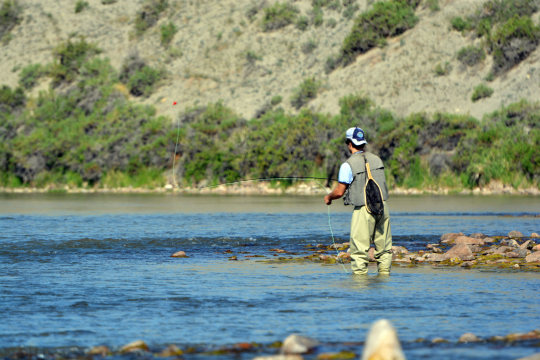
North Platte River, Wyoming
The North Platte River is the only floatable waterway in central Wyoming and has become the destination fishery for the state. Scenic and recreational values of the North Platte River are derived from a combination of environmental factors and management practices. The river is highly valued as a class 1 fishery. The Wyoming Game and Fish Department has rated it as a blue ribbon fishery. Game fish species include rainbow, brown and cutthroat trout. The most common recreation activities are fishing, floating, waterfowl hunting, and observing wildlife. There are also opportunities for picnicking and camping. This river has become a vital part of the social and economic values of central Wyoming.
ll anglers on public lands must have the required state license(s). That’s because states are responsible for managing wildlife within their borders for the trust and benefit of their residents, even if the hunting occurs on federal lands. You can search for state fishing licenses on the U.S. Fish & Wildlife Service website.
For more river trips ideas, check out the Department of the Interior’s blog!
#FindYourWay#find your way#fishing#boating#recreation#yourpubliclands#wildlife#adventure#discovery#outdoors#water#road trip#bureau of land management#wild and scenic rivers#rivers#makeyoursplash
57 notes
·
View notes
Text
How did Dolly Parton, Reba McEntire, Carrie Underwood do?
CLOSE

The 2019 CMA Awards highlighted women and their music with an all-female opening performance. USA TODAY
Hey Hollywood, take a note from Nashville: Hosting is in again.
This year both the Oscars and the Emmys telecasts went without hosts, getting oh-so-close to setting a trend that declares audiences don’t need jokes in between the rich, beautiful and famous giving each other trophies. Spoiler alert: They do.
The Oscars snuck through with a watchable ceremony by a hair’s-breadth, but the Emmys were all the proof we needed that hosts are essential to an awards show. Gaps need to be filled, segues need to be made and costumes need to be changed.
The 2019 CMA Awards, which aired Wednesday on ABC, understand this, and when they took a big swing with their hosting this year, they (correctly) assumed that more is better.
After several years of Carrie Underwood and Brad Paisley hosting the show to varying degrees of success, the Country Music Association instead tapped Underwood along with legends Dolly Parton and Reba McEntire for a show themed around celebrating female artists in the genre. The trio led an upbeat night full of affirmations, sequin dresses and a lot of jokes about Parton’s, ahem, assets.
The CMAs have always had a more casual vibe than other awards shows, and not just because of the black-tie-optional dress code. And while Underwood and Paisley always did an adequate job, linking Underwood with Parton and McEntire gave the whole event the vibe of a family reunion, an intimate gathering between people who like one another, and probably like you at home, too.
What a start: CMA opening with one dozen female country artists is ‘epic celebration’
More: CMA Awards 2019: List of winners
Autoplay
Show Thumbnails
Show Captions
Last SlideNext Slide
The three had an effortless chemistry, and their casual banter was far more successful than scripted gags. Thankfully the bits were kept to a minimum (another improvement over the Underwood/Paisley years) and the chuckles and smiles were free-flowing.
The Emmys need a host because they’re overflowing with categories, and the CMAs are likewise overflowing with performances. Underwood, McEntire and Parton were clutch in keeping the evening moving (and helping get the few awards handed out during pauses in the singing).
CMA Awards 2019: Jenee Fleenor becomes first woman to win Musician of the Year
Thankfully, the entertainment industry hasn’t left hosts behind entirely. NBC announced this week that Ricky Gervais will return to host the 2020 Golden Globes (although that comes with its own set of problems), and the Grammys confirmed that Alicia Keys will be back to emcee music’s biggest night.
As famous as Gervais is for his mean streak, these events don’t need someone controversial or edgy to keep things rolling, as the CMAs proved. Sometimes you just need a host (or hostess) with the most, someone to keep the lights on and the smiles flowing, and make it worth staying up until 11 on a weeknight.
Autoplay
Show Thumbnails
Show Captions
Last SlideNext Slide
Read or Share this story: http://bit.ly/2CO905b
Sahred From Source link TV and Movies
from WordPress http://bit.ly/2rSGU6H via IFTTT
0 notes
Text
Trading Psychology Session - Wish Trading
Obtain the Data You Need to Evaluate Stock Trading Computer software
In today's market, investors are wondering if they need to actually buy shares and if they can produce money. The clear answer to equally is "yes." Stock market trading is an excellent possibility today, with rates decrease and volatility greater than in lots of years. Stock trading on the web hasn't been more popular. xm zero spread account
Automatic trading systems, robotic trading programs, on the web day trading systems-there are many terms used to explain the stock trading systems that could enable you to produce a stock investment and to develop your money. Evaluation the criteria below and understand your personal personal tastes by talking with different stock traders. Identify the facts you need to assess programs. You may need a good comprehension of the computerized trading resources'features and costs when you produce a decision.
Many types of organizations present stock trading assistance and stock trading strategies. They work the gamut from educational programs that make an effort to educate you on just how to trade, to a listing of advised shares to buy and promote at specific sparks, to brokerage company private application, all how you can completely computerized robotic software. Rates may vary from tens and thousands of pounds to less than $50 a month for many vehicle trading software. With this kind of variety, how will you pick? This information will manual you through the features and advantages of the programs which can be available for on the web stock trading. We will not examine trading application for alternatives or Forex trading. Most of the programs are aimed at "day traders," who theoretically open long positions (buy) or small positions (sell short) and close these positions the same day. Not everyone who employs these programs closes out their positions by the conclusion of the trading day--sometimes they maintain their positions for days, months or months. We'll contact that "effective trading." Occasionally this really is also known as "swing trading."
The essential top features of a stock trading plan include a information give for stock estimates and signs, stock maps or charting capability of important signs, recent harmony and positions and an get entry system. The get entry process must let end (loss) requests, end limit requests and trailing stops. A trailing end limit is comparable to the end (loss), except its reduction will be calculated from the shares best position achieved. The preferred method would be to keep carefully the trigger rates in stealth method, maybe not watchable by the market makers, rather than as actual orders. Most computerized trading application includes a watch list of the shares to perhaps trade based on the parameters the stock trader has entered.
Exchange Traded Funds (ETF's) may be part of an efficient trading strategy. They're mutual funds which can be exchanged intraday on the stock transactions, unlike traditional mutual funds which can be a basket of securities coming in at the close of the market. On line stock trading systems should also include trading functions for ETF's.
Different features to find include security methods that stock traders will take, such as for instance establishing a gain goal--the minimum price increase a trader would assume a stock to achieve before shutting their position. Also very attractive is a form of profit security for the investments, which can be the paid down profit goal. Following the stock reaches its profit aim and continues to increase, the stock trading application must delay and allow profit increase. If the stock price reduces or pulls right back, the online trading plan must close the position and lock the profit. That pullback value must not have any influence ahead of the profit aim is achieved and is meant to improve stock performance. More innovative vehicle trading programs will also provide proportion get from stock trader's entry price, and the trader may also establish the absolute minimum volume in case the proportion gained is also low.
Check always the Characteristics and Question Issues
Number of Specialized Signals - There are practically hundreds of signs that stock traders can use to find out which shares to buy and promote and when. The most powerful programs will present hundreds of signs for complex analysis, such as for instance Bollinger Bands, and some will include signs for Candlestick Graph formations. Robotic programs use these signs to create problems below which on the web trading will occur.
Complexity - Automatic stock trading programs vary considerably in ease of use. Some on the web stock trading systems do need actual programming expertise. Others are only position and click. Browse the on the web demo to see so it suits your degree of comfort before creating a commitment. Speak with other individuals who are using the vehicle trading sites and have a look at their on the web towns for more comments.
Number of Long and Short Methods Per Account - Because of the size of the online trading platform, there might be a limit to the number of methods that you'll have packed on each account. If you want to work, state two long trading methods, then you might need two accounts. Also verify when you have enough storage on your pc for several accounts. Experienced effective traders may possibly work several live long and small methods, whilst having extra accounts for methods that they are screening in a simulation mode.
0 notes
Photo



Happy Birthday the actor, Sean Connery, was born on 25 August, 1930 in the Fountainbridge area of Edinburgh.
Christened Thomas Sean Connery, named Thomas after his grandfather, his mother "Effie" was a cleaner ad his faither was a factory worked and lorry driver, so he really is a "local boy made good". Connery has said that he was called Sean, his middle name, long before becoming an actor, explaining that when he was young he had an Irish friend named Séamus and that those who knew them both had decided to call Connery by his middle name whenever both were present. He was also called "Big Tam" around Fountainbridge.
Prior to being bitten by the acting bug, Connery lived a rugged blue collar life as a labourer, a lifeguard, a cab driver and a bodybuilder. Never one to shy away from a scrap, Connery is said to have won many more fights than he lost.
Once committing to a life on the boards, Connery popped up in westerns, as a villain in a Tarzan movie and even a Walt Disney family film, 'Darby O'Gill and the Little People'. Everything changed for the Scot when he was cast (against author Ian Fleming's wishes) as the agent with a license to kill, James Bond, 007 in 'Dr. No'. Fleming initially thought that Connery was too brutish and unrefined. However, after seeing Bond come to life in 'Dr. No', Fleming came around, to the extent that he wrote a Scottish lineage in Bond's background.
Connery essayed the suited hero in five more 'official' Bond adventures, retiring the role for good with the unofficial Bond film, 'Never Say Never Again', in 1983.
Finding his creative footing after Bond took awhile. While always an actor with great range, Connery struggled against being typecast in a role that the world wasn't ready to see him walk away from. Even so, he continued working as a leading man with varying degrees of success. Despite a spotty run of films, he's always watchable and starred in some unjustly overlooked gems, such as the exciting 'The Great Train Robbery' (which features Connery running across the top of several train cabins at 60 mph with no stuntman!), Casablanca-esque 'Cuba' and my favourite of hs post Bond films, the immortal 'The Man Who Would Be King', with best friend Michael Caine.
In 1987, everything changed with Connery's Oscar winning performance as Mike Malone in 'The Untouchables'. As a tough, Irish mentor to Kevin Costner's green Elliot Ness, Connery owned every scene he was in. He was funny, scary and relentless in his quest to clean up the streets of Chicago and teach younger agents how to survive in the wild, wild Midwest. I disagree with Sickboy in the Irvine Welsh book Trainspotting who slates The Untouchables and the Oscar by saying, " (That) means fuck all. It's a sympathy vote.
He went on to star in number of hit films, including 'The Rock', 'The Hunt for Red October' and of course as the father of another iconic screen hero in 'Indiana Jones and the Last Crusade'.
A wee fact I picked up when researching this post was that Sean donated his entire million dollar fee from 'Diamonds Are Forever' to the Scottish Education Trust.
Connery was married to actress Diane Cilento from 1962 to 1973. They had a son, actor Jason Connery.
He has been married Moroccan-French painter Micheline Roquebrune since 1975 and has retired from filmmaking.
As well as his Oscar Big Tam has a number of other accolades, having been polled as "The Greatest Living Scot" and "Scotland's Greatest Living National Treasure". In 1989, he was proclaimed "Sexiest Man Alive" by People magazine, and in 1999, he was voted "Sexiest Man of the Century".
110 notes
·
View notes
Text
The Predator
The late 80′s and early 90′s saw films like Predator, Total Recall and The Abyss standing out as technological achievements unparalleled in cinema history. With time now having passed and CGI having developed exponentially since then it’s become clear that what makes Predator and Total Recall in particular memorable is not that CGI but the storytelling that went along with it. One only need look at every subsequent chapter of the Predator story and the 2012 remake of Total Recall to conclude that CGI alone will not result in a product of lasting value. Every generation has it’s technological advances but only a few have the foresight to couple them with something of lasting value.
That’s not to say that the Predator films have not been watchable. The first one was fabulous and the rest have to varying degrees been fabulously bad. The Predator, directed by Shane Black, who appeared in the first film and may have had an uncredited hand in the screenplay, continues that trend. Boyd Holbrook stars here as Quinn McKenna, an American sniper who is unfortunate enough to have a close encounter with a Predator in the opening scenes. He manages to find his way out of that predicament with some alien artefacts in hand. Sending those back to the US, they are unexpectedly found by his disabled son who unwittingly sets off a chain of events that could spell either the end or the saving of human kind.
Meanwhile, the Predator from the opening scenes is in the custody of some shady government agency under the leadership of Traeger, played by the excellent Sterling K Brown. He’s bought in Casey Becket (Olivia Munn) to examine the Predator in search of answers to some so far unanswerable questions. What ends up happening with Becket, Traeger, McKenna and his posse of military prisoners is entirely predictable. So predictable in fact that Black at some points dispenses with storytelling altogether and simply time warps between scenes. That can be frustrating at times but once you know what he is doing you pretty much become use to it.
What Black has most obviously decided to do is take the violence and humour from the Predator series and up it to 110%. The extreme violence borders on farcical at times but it is very well done. The humour is crass and always quite dark with much of it succeeding in lancing the earlier films in the series and other stock standard 80′s action franchises. None of it is laugh out loud funny but some of it you can’t help but smile at.
If you are a Predator nut, watch this film. There is enough cool stuff here to enjoy. It does not overstay it’s welcome with a running time of under two hours. If you’ve never seen a Predator film before this is probably not the time to start.
0 notes
Text
Watched Dig Two Graves, American Fable, the Void and Ejecta last night with varying degrees of enjoyment. Looking for another few horror/thriller/sci-fi movies to watch tonight but haven't found anything interesting yet. If anyone has any recs, lay em on me. I'm not looking for mind blowing amazing, just something watchable.
0 notes
Text
Mudbound
(Dee Rees, 2017)
Another year, another film with which Netflix attempt to break into the prestige cinema racket. Returning with her third directorial effort 2 years on from small screen biopic-ing with Bessie, Dee Rees gets to paint on a canvas far greater than either said HBO effort, or her much lauded debut Pariah allowed, and for the most part she proves herself a dab hand.
With Mudbound, her adaptation of a much lauded novel by Hillary Jordan, Rees tackles the seemingly eternally relevant subject of racism through the prism of life in the deep south in the 1940s with occasional diversions to war torn Europe. The screenplay, penned by Rees in collaboration with Virgil Williams is maybe the weakest aspect of the film. Make no mistake, there is plenty to love in here, the film does a generally strong job of having the majority of its characters exist within grey areas rather than reducing everyone to black and white.
Set in a world in which the KKK reign, and racism is open and everywhere it’s impressive that the majority of the movies ideas on the racial divide as relates to the world today are communicated in less direct means, through action, and intention, and experience rather than monologue. Some credit also to the voice over narration that permeates the movie in far less offensive fashion than is often the way, more early era Malick than pre-92 Blade Runner, given the depth of feeling in the delivery, and almost Sorkian lyrical musicality of the words.
It’s not easy to make it work to that degree, but they pull it off, in addition to everything else it works because within a film that is as much as anything about divisions between people who live next door to each other, the ability to communicate internal feelings so eloquently, while nothing but trouble comes across externally adds another layer to the film. Sadly, it isn’t quite perfectly pulled off because ultimately too much of what is being communicated internally also gets expressed one way or another externally, rendering much of that narration superfluous in the way voiceover usually is at its worst.
Anyway, the thing primarily works because within the frame of that shadowy, stormy, gloomy, candle lit chiaroscuro photography of Rachel Morrison aforementioned flawed screenplay is brought to life by a tremendous cast, Rees’ knack for eliciting strong performances still as present as ever. Jonathan Banks saddled with the least interesting character in show, but a world away from the character that made him world famous (all talk rather than all restraint) he gets to display his range. Mary J Blige seems to be drawing most headlines, she’s the most famous name on show, but her role is relatively small. It’s admirable how effortless her performance is, how naturally and without fanfare she blends into proceedings, that discipline the most notable thing about the turn. Garrett Hedlund continues to offset with his movie star looks, and superstar voice with another in a long line of wonderfully varied character turns, and his scenes with the ever ascending Jason Mitchell prove some of the movies highlights, probably their heart. Jason Clarke is the heart of the thing, it is within him that the central conflict, the emotional tug of war between one side and the other is most embodied, and the way he plays it right down the line is a credit to him.
Still, for me the highlights of the movie are Carey Mulligan and Rob Morgan. Mulligan, a world away from the very British work with which she resurrected her reputation in 2015 proving, like Blige, displaying an ability to disappear seamlessly into her character, into this world, and bring her grace to graceless lands. Morgan, whose most notable previous work is probably his small parts in other recent Netflix series’ Daredevil, and Stranger Things is the on screen star of the show for me, certainly in the early stages when it is he, as much as the photography, writing, music of anything else that lends flavour and earthy heart to this story, that lends it a feeling of authenticity. His ability to communicate so much while doing so little is at a level beyond what you might expect from someone whose career has been dominated by small projects, and small roles. Hopefully this will make him the star he deserves to be.
Mudbound overall on account of all their contributions is a very engaging, very watchable, very well made film. It’s far from perfect, but it establishes strong characters, juggles multiple thematic strands with great power, is handsome as hell to behold with a certainly very literary air hanging over the whole thing that lends it all a touch of class. It’s heavy, but it’s worth it.
#mudbound#dee rees#hillary jordan#virgil williams#rachel morrison#jason clarke#jason mitchell#carey mulligan#garrett hedlund#mary j blige#mary j. blige#rob morgan#jonathan banks#2017#reviews#film#films#movie#movies#netflix#adaptation#adapatations#novel#historical
5 notes
·
View notes